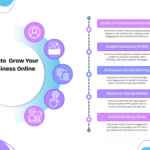If your website isn’t bringing in new leads, you’re not alone. Many local businesses from dental clinics to fitness studios and salons invest time and money into building a website, only to be met with silence. No calls, contact forms and appointments. Just… crickets.
That’s frustrating, especially when your business depends on bringing people through the door.
The truth is, having a website doesn’t automatically mean you’ll get leads. And if your website isn’t performing the way it should, there are usually a few common reasons why like slow load times, broken pages, or missing trust signals.
But here’s the good news: these issues are fixable. And with a little effort, your site can go from “just a placeholder” to a steady source of leads.
Let’s break down why your website might not be generating leads and what you can do to turn that around.
Common Reasons Your Website Isn’t Generating Leads
Before diving into solutions, it’s important to understand where things might be going wrong. Most lead-generation issues come down to one or more of the following problems:
Slow Loading Speed
People are impatient, especially online. If your website takes more than 3 seconds to load, many visitors will bounce before they even see your homepage.
How to check it:
Use free tools like Google PageSpeed Insights or GTmetrix to test your site’s loading time.
Why it matters:
Not only does a slow site frustrate users, but it also hurts your SEO. Google penalizes slow-loading websites in search rankings, which means fewer people find you in the first place.
Broken or Down Pages
Ever clicked on a website link and landed on a “404 Not Found” page? It’s a quick way to lose trust — and lose a lead.
Signs of the problem:
- Pages not found or showing errors
- Broken internal links
- Website downtime or hosting issues
How it affects leads:
People won’t dig around for what they need. If your contact form or service page is broken, they’ll simply go to a competitor.
Unattractive or Outdated Design
Your website design is like your storefront. If it looks old, cluttered, or hard to use, people may assume your business operates the same way.
What turns people away:
- Clashing colors or small fonts
- Hard-to-read layouts (especially on mobile)
- Outdated images or content
The fix:
Modern, clean design with a clear navigation menu can dramatically improve user experience. It helps people find what they’re looking for quickly and builds credibility from the start.
No Trust Signals
You wouldn’t hire a contractor without checking reviews, right? Your website visitors feel the same.
Missing elements to watch for:
- No testimonials or reviews
- No visible contact info or address
- No awards, certifications, or affiliations
What to do:
Add real testimonials, client logos, or star ratings. Even showing a photo of your team or office can help visitors feel more confident in reaching out.
Missing or Confusing Calls-to-Action (CTAs)
What do you want visitors to do? If your site doesn’t clearly tell them, they probably won’t do anything.
Examples of weak CTAs:
- A tiny “Contact” link buried in the footer
- No clear next step on your service pages
- Confusing buttons or multiple CTAs on one page
Better approach:
Use strong, simple CTAs like:
- “Book a Free Consultation”
- “Get a Quote Today”
- “Call Now to Schedule an Appointment”
Place them prominently, especially above the fold and at the end of each page.
Low or No Website Traffic
Sometimes the problem isn’t your site’s design, it’s that not enough people are seeing it in the first place.
Common traffic blockers:
- Poor SEO optimization
- No local search presence (Google Business Profile missing)
- Little to no content marketing
Quick traffic tips:
- Optimize your pages with relevant keywords (like “[City] hair salon” or “best chiropractor near me”)
- Create helpful blog content or FAQs
- Make sure your business is listed in local directories
So, How Do You Fix All of This?
It might sound like a lot, but the right approach can help you fix these problems step by step.
Here’s what a well-rounded strategy looks like:
1. Audit Your Website’s Performance
Start with a full review of your site’s health, speed, errors, mobile responsiveness, and usability.
Tools like Google Search Console and GTmetrix can help, but if you’re not technical, consider a service that does it for you.
🛠️ Our Website Conversion Audit & Optimization Service is built for non-technical business owners. It identifies exactly what’s stopping your site from converting — from page speed to design to calls-to-action.
2. Optimize for Speed and Uptime
Make your website load fast by:
- Compressing images
- Minimizing code and scripts
- Upgrading your hosting plan
- Installing caching plugins (like WP Rocket)
Also, monitor for downtime. A website that’s frequently offline won’t inspire confidence — or get leads.
3. Modernize Your Design
Focus on clean, professional layouts with:
- Easy-to-read fonts
- A mobile-friendly layout
- High-quality images
- Clear navigation
Keep it simple. Don’t overwhelm users with too many options or clutter.
4. Build Trust with Visitors
People are more likely to reach out when they feel like they can trust you.
Quick ways to add trust:
- Include real reviews or testimonials
- Use “as seen on” or certification badges
- Display your contact info, address, and photos of your team
5. Make Your CTA Clear and Compelling
Each page should have one clear goal. Use buttons and text that guide users to take action.
Examples:
- “Book Your Free Trial Session”
- “Get Started with a Quick Call”
- “Claim Your First Visit Discount”
Use a mix of buttons and forms, and make sure they’re mobile-friendly.
6. Drive More Traffic with Local SEO
If you’re a local service provider, SEO is one of the best ways to attract high-intent traffic.
Steps to take:
- Optimize your website for your city and niche
- Get listed in Google Business Profile
- Ask happy customers to leave reviews online
- Add location-specific keywords in your page titles and content
Wrapping It Up
If your website isn’t generating leads, don’t give up chances are, it just needs a few smart tweaks. Speed, trust, design, and clear calls-to-action all play a huge role in turning visitors into customers.
Not sure where to start? Begin by reviewing your site’s speed, checking for broken pages, and updating your design and CTAs. These small changes can make a big impact.
✅ Want a hand with all of this? A Website Conversion Audit & Optimization Service can help you uncover what’s holding your site back and show you exactly how to fix it.
Ready to turn your website into a lead machine? Let’s get started.



